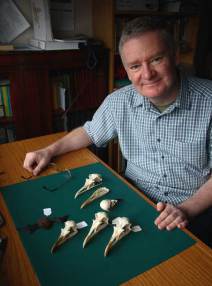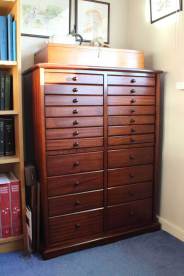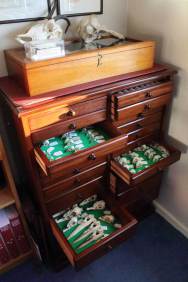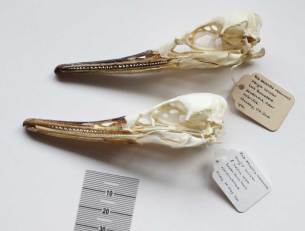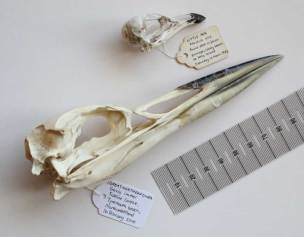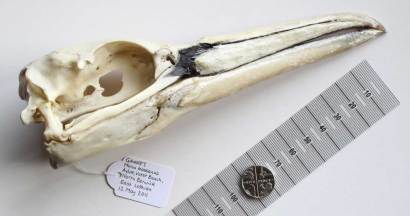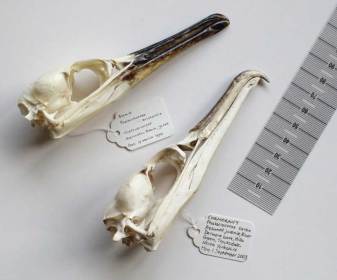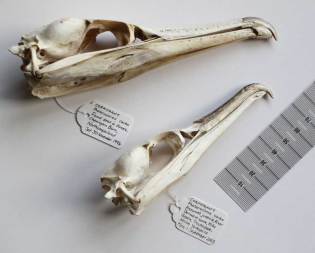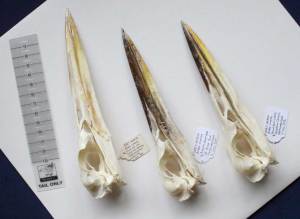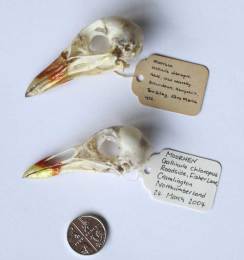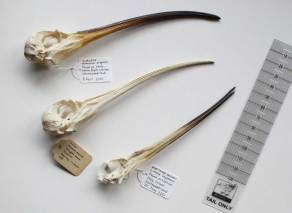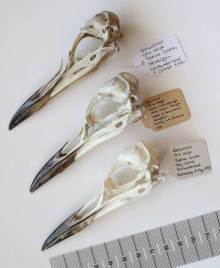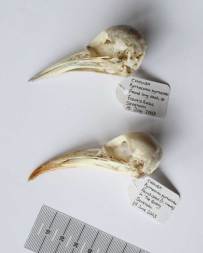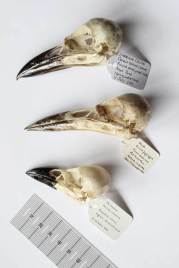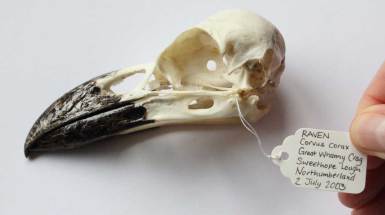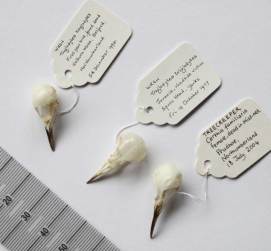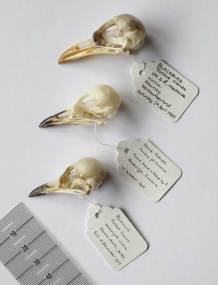The Steve Holliday skull collection
Introduction … …
This page shows part of the skull collection created by Steve Holliday, a friend of mine. Steve has been a keen ornithologist from an early age and collected remains from birds and mammals found dead, learning to produce and preserve their skulls. This has resulted in a wonderful collection comprising many specimens, each of which involved hours of painstaking work … a triumph of real quality. The photograph (below) of Steve was taken with some of his specimens in 2014.
If you select each photograph below, it will enlarge. For display purposes and ease of use, these picture versions are restricted to 72 dpi. For scale a ruler (mm) may be included or perhaps a five pence piece (18 mm diam)
A note from Steve Holliday ... ...
Firstly, let me extend my thanks to Dan Turner for photographing my collection and sharing many of the items on his website – thank you. My interest started at a relatively young age, sparked by my uncle who collected his first, a Redstart, in 1968. My uncle’s collection of around 40 specimens was then passed to me in the late 1970s and I prepared my own first specimen, a Goldfinch found on Thorne Moors, in 1977 – the first of 16 skulls collected that year. Over the years I have been very grateful to both friends and family for collecting interesting items for me and 41 different names are listed on the labels as providing specimens. In total, the collection reached over 330 items by the end of 2015, which included 167 different species of bird. A further 23 specimens were prepared for Dan’s Beached Bird Collection during 2010-2015.
Failing eyesight and shoulder issues have made it impossible for me to undertake the close-up steady work required and none has been prepared since 2015. Despite continuing to bring me great pleasure, I didn’t want to see the collection disappear under a cloud of dust in the long-term. Also, whilst recognising the rarity ‘value’ of some of the skulls in the collection e.g. Ascension Frigatebirds, White-tailed Lapwing and several Eurasian Curlews, I decided to make arrangements for their long-term protection, whilst also enabling good use to be made of the collection. In this regard I am delighted that arrangements were made with Dr Andrew Kitchener at the National Museum of Scotland and the collection was handed over in February 2018. Dan’s efforts on this website also ensure that we have a suitable visual record in the public domain. I’m delighted with both outcomes.
Steve Holliday
February 2018
Photographs showing some of Steve's specimens follow, below,
with texts prepared by Dan Turner ... ...
(This section will be augmented in the future)
Red-breasted merganser Mergus serrator
Two specimens of this wonderful sawbill … just look at those serrations! The upper specimen was found dead by Roy Holliday (Steve’s uncle), June 1974, on the moor of Loch Borosdale, Benbecula, in the Outer Hebrides of Scotland. Here is an extract from A history of British birds (Morris, F.O., Vol VII, page 102, ca. 1880) … ‘Their food is chiefly made of small fish, but also of beetles and water insects and their larvae, worms, and frogs. The note sounds most like the words, ‘curr, curr.’ The places chosen by this species for nesting, are the vicinage of the sea, and the neighbourhood of lakes and rivers, among reeds and rushes.’
Great northern diver Gavia immer and little auk Alle alle
This large diver was found dead on Tynemouth Longsands by Maggie Sheddan (15 Feb 2010), from the Scottish Seabird Centre, and collected the next day. The bird was complete, but not pristine; culmen length was 76.4 mm when measured on the beach and wings were 345 and 348 mm. A rare find; its head and right wing were collected. This is the only skull of great northern diver in Steve’s collection. The little auk is included to show size difference. The culmen of beached little auks in northeast England during 2005-2007 ranged from 13.0 to 18.8 mm in length (D.M.Turner data).
Northern gannet Morus bassanus
This skull and bill came from an adult specimen (head and neck only) found at North Berwick, west beach, on 12 May 2011 by D M Turner. Just offshore from North Berwick is the Bass Rock with a breeding population which has been recorded to hold more than 150,000 individual northern gannets. Gannets were recorded off the coast of Northumberland every month during 2016 (Birds in Northumbria 2016, Northumberland and Tyneside Bird Club, 2017)
Great cormorant and European shag
These two specimens are similar in length, with a culmen measuring around 60 mm, based on the scale in the photograph. This is a typical length for European shag, but for Great cormorant may indicate small female P.c. carbo or a male or female P.c. sinensis (J.B. Nelson, 2005; Pelicans, Cormorants and their relatives The Pelecaniformes; Oxford University Press). This cormorant was found on 1 Sept 2003 and, due to its size, the finder considered it may have been a juvenile bird.
Great cormorant, two specimens
The size of the upper specimen indicates a male P.c. carbo. It was found on 30 November 1996 in the dunes at Chevington Burn, Northumberland, by Steve Holliday. The lower specimen (from North Yorkshire) indicates a small female of this race. Alternatively, if it was of the race P.c sinensis, then the bill length indicates it may be a male or female individual. (Reference: J.B. Nelson, 2005; Pelicans, Cormorants and their relatives The Pelecaniformes; Oxford University Press).
Grey heron Ardea cinerea
The three grey heron skulls in the Steve Holliday Collection are shown below; each bird was found dead. From left to right they are: (1) adult, Stockton-on-Tees, County Cleveland, 5 April 1985, found by Steve Holliday; (2) juvenile, Arcot Pond, Northumberland, 10 July 2010, Phil Allott; (3) juvenile, near Woodhorn church, Northumberland, 7 May 2012, Steve Holliday. The Popular Handbook of British Birds (Hollom, 1952; fourth edition, with revisions, 1982) states … ‘Incubation is by both sexes apparently for about 25 days. The young are fed by both sexes and fly when about 50-55 days old. Sometimes double-brooded.’ and … ‘The breeding population of England and Wales in 1954 was nearly 10,000 birds.’
Moorhen Gallinula chloropus
The upper specimen is from an adult, a road casualty from Hampshire found by Roy Holliday in March 1972. An average moorhen clutch holds six eggs and, during the three week incubation period, both male and female take turns to keep the eggs warm. Moorhens raise two to three broods and first-brood chicks can help feed chicks from the pair’s second brood. In Cheshire and the Wirral (England), Breeding Bird Survey data showed an average of about seven pairs, with probable or confirmed breeding, per tetrad in 2004-2005 i.e. a breeding population of 7,940 birds which was greater than 2.2% of the British population (Birds in Cheshire and Wirral, Norman, D. 2008).
Curlew Numenius arquata and bar-tailed godwit Limosa lapponica
The upper two specimens, with downturned bills, are curlew while the third individual with upturned bill is bar-tailed godwit. Both are elegant wading bird species while the curlew is the taller. A curlew’s call is strident and far-reaching with a variety of notes and gorgeous, descending, vibrant warble enough to brighten any landscape. The top curlew was from North Blyth staithes, Northumberland, found on the shore, 8 April 2001. A total of 88 curlews were recorded in Blyth estuary the next day (Birds in Northumbria 2001) while during 1990-1999 the max. curlew count at Blyth estuary was 106 one March (Blyth Birds, Steve Holliday, 2000). The bar-tailed godwit was a tideline corpse from Holy Island (i.e. Lindisfarne), Northumberland, 30 May 2001. ‘Lindisfarne is one of Britain’s most important areas for the [bar-tailed] godwits …’ (The birds of Holy Island, Ian Kerr, 2007, page 44).
Common guillemot Uria aalge
Two of the three common guillemot specimens below were found on the coast of Northumberland (10 May 1995 and 7 Oct 2012), the third was from an oiled corpse on a Hampshire beach (14 Jan 1972). During the three winters from 1996-1999 guillemots were recorded in low numbers along the Northumberland coastline. From 46 occupied tetrads (2 x 2 km squares), six held 10-19 birds, 39 held 1-8 birds and the other tetrad held 200 feeding birds in January 1999 (The Atlas of wintering birds in Northumbria, Day & Hodgson, Northumberland & Tyneside Bird Club, 2003). The Farne Islands breeding population in 2015 was estimated at 35,820 pairs (Northumbrian Naturalist, 2016, Volume 80).
Chough Pyrrhocorax pyrrhocorax
These two chough specimens from Steve’s collection came from the island of Skokholm off the southwest coast of Wales. Both were found in the summer of 2003 by warden Graham Thompson and donated to Steve that August. The lower bird, found 29 June, had been dead about a month, when found, and carried a colour ring; it had been raised in a nest with a brood of four the previous summer at the Castlemartin coast SPA, Pembrokeshire. Here is a quote from the lovely book Lambert’s birds of shore and estuary (Lambert & Mitchell, 1979) … ‘The Chough is a glorious flier, sweeping, diving and soaring along cliff-faces with complete mastery of the air and can do the Raven’s trick of rolling over on its back.’
Carrion crow, rook and jackdaw.
Three different members of the crow family are shown here. The top bird, a juvenile carrion crow Corvus corone, was found dead at Arcot Pond, Northumberland in July 2011 by Phil Allott. The central rook Corvus frugilegus was found dead in North Yorkshire, November 1991 (Roy Holliday), while the smaller jackdaw Corvus monedula was an October 1994 bird from Ingram, Northumberland (found by Steve Holliday).
Most British and Irish rooks are resident, but some immatures may move up to 100 km while birds from Scandinavia and the Netherlands can cross the North Sea to winter in eastern Britain (RSPB Handbook of British Birds, fourth edition, 2014, Holden & Cleeves).
Raven Corvus corax
In the UK the raven has expanded its range into lowland areas since the 1990s accompanied by the use of quarries for nesting as well as making extensive use of trees. This large crow species is now to be found over most of Ireland and Britain apart from a clear band in the east (Bird Atlas 2007-11, Balmer et al, 2013). In Britain 7,000 pairs were noted during 1988-91 (Snow & Perrins, 1998). The photograph shows the skull of a bird found dead in Northumberland by Martin Davison (Chairman of the Northumberland & Tyneside Bird Club) in July 2003.
Treecreeper and wren
The treecreeper Certhia familiaris, at bottom of picture, was collected at Prudhoe, Northumberland, in July 2004. Birds in Northumbria (Northumberland and Tyneside Bird Club) recorded a strong autumn passage that year with many at and close to the coast. At top of picture, the wren Troglodytes troglodytes was a first-year specimen from Belford, Northumberland, collected on 5 December 1994 by Dee McKeown and Graeme Bowman. The wren is a widespread species found from coastal scrub to woodland, upland farms and moorland fringes as noted in The Birds of Durham (Durham Bird Club, 2012).
Blackbird, song thrush and redwing
Three members of the thrush family are shown below. The blackbird is a first-summer male, roadside victim, Northumberland, found 29 April 1995. The song thrush was found dead in Cumbria on 27 October 1994. The redwing was from Yorkshire, a motorcycle road casualty found by Steve Holliday on 10 December 1977. The nominate race of the redwing Turdus iliacus iliacus winters throughout Britain, after arrival from Scandinavia, with fewer present in Ireland (Bird Atlas 2007-2011, Balmer et al., 2013, BTO). This attractive thrush is a rare breeding bird in northern Scotland.


